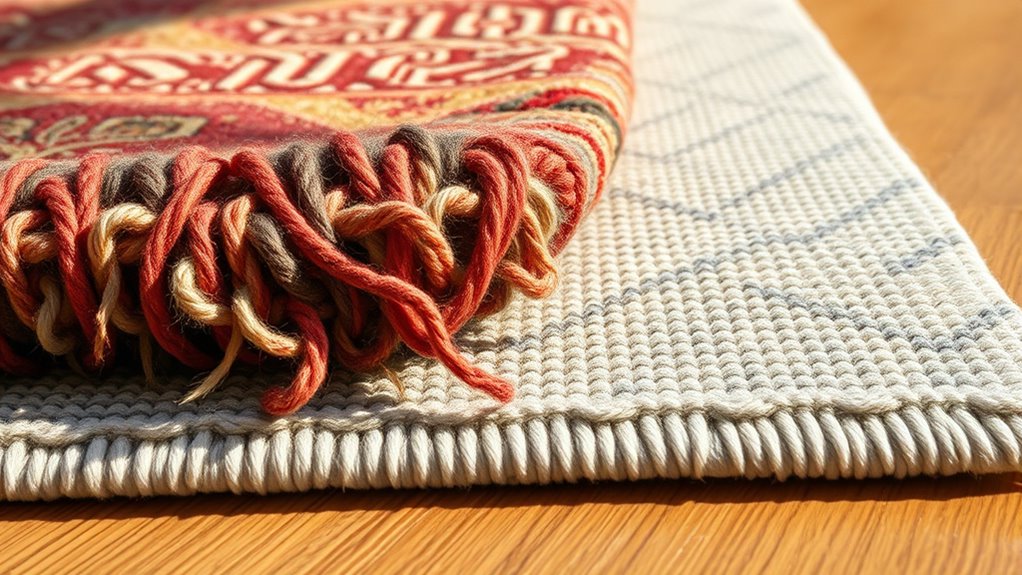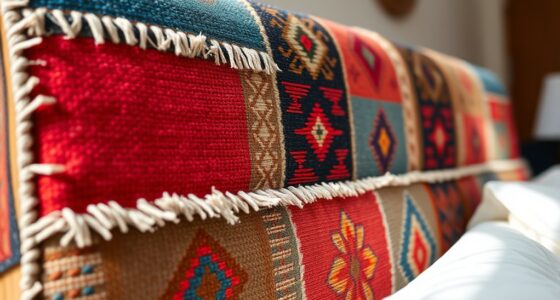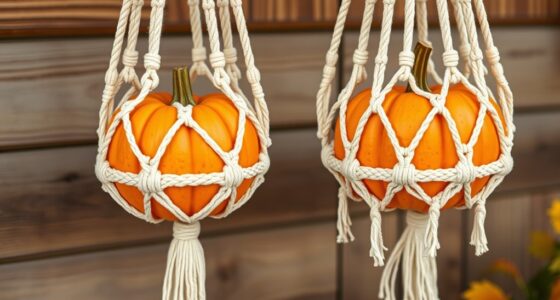When layering rugs on heated floors, choose hand-knotted rugs for durability, natural heat resistance, and high-quality materials that last longer. Machine-made rugs are more affordable but may soften or warp under heat, making them less suitable for long-term use on warm surfaces. Opt for lightweight rugs with proper pads to prevent heat trapping and slipping. Want to discover more about how to make your layered rug look stunning and stay practical? Keep exploring for the details.
Key Takeaways
- Hand-knotted rugs offer dense, natural fibers with better heat resistance, making them suitable for layering on heated floors.
- Machine-made rugs tend to be lighter and may trap less heat, but their synthetic fibers can soften or warp under high temperatures.
- For layered rugs on heated floors, choose lightweight, non-dense options and use non-slip pads to prevent slipping and ensure heat circulation.
- Hand-knotted rugs provide durability and insulation, enhancing their performance and longevity on heated flooring systems.
- Verify manufacturer guidelines for both hand-knotted and machine-made rugs to ensure compatibility and optimal heat resistance.
Understanding the Craftsmanship Behind Hand-Knotted Rugs
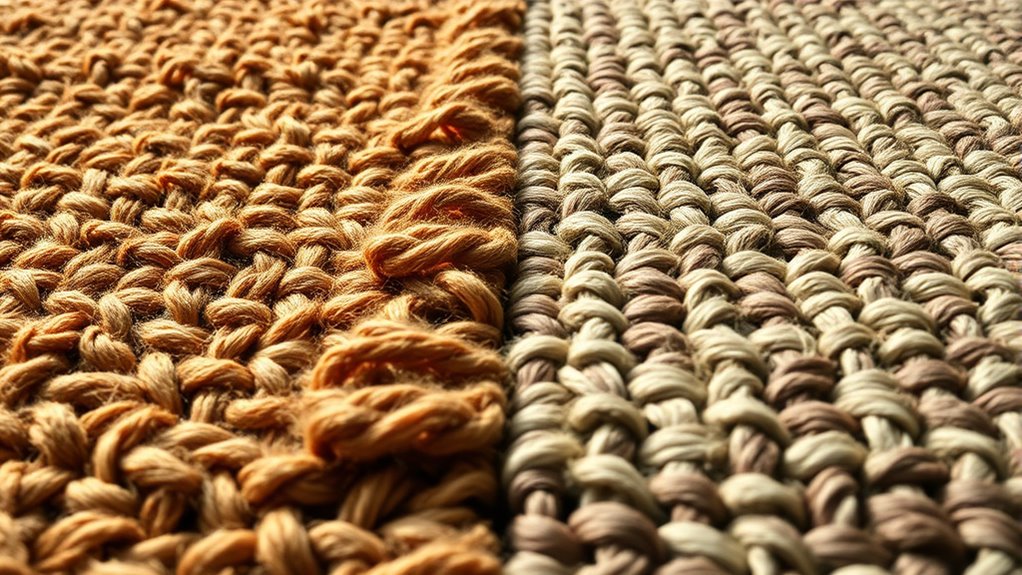
While hand-knotted rugs may seem like intricate works of art, their craftsmanship is rooted in a precise and labor-intensive process. You’ll find that each rug is created knot by knot, with artisans meticulously tying individual fibers onto a sturdy foundation. This process can take months or even years, depending on the rug’s size and complexity. Every knot contributes to the rug’s durability, texture, and unique pattern. Skilled artisans often pass down their techniques through generations, ensuring quality and tradition are maintained. The craftsmanship involves careful selection of high-quality materials like wool, silk, or cotton, which are dyed using natural or synthetic methods. This attention to detail results in a rug that is not just decorative but also a lasting investment in artistry and culture. Additionally, the use of natural materials enhances the authenticity and longevity of the rug, making it a true testament to traditional craftsmanship.
The Manufacturing Process of Machine-Made Rugs
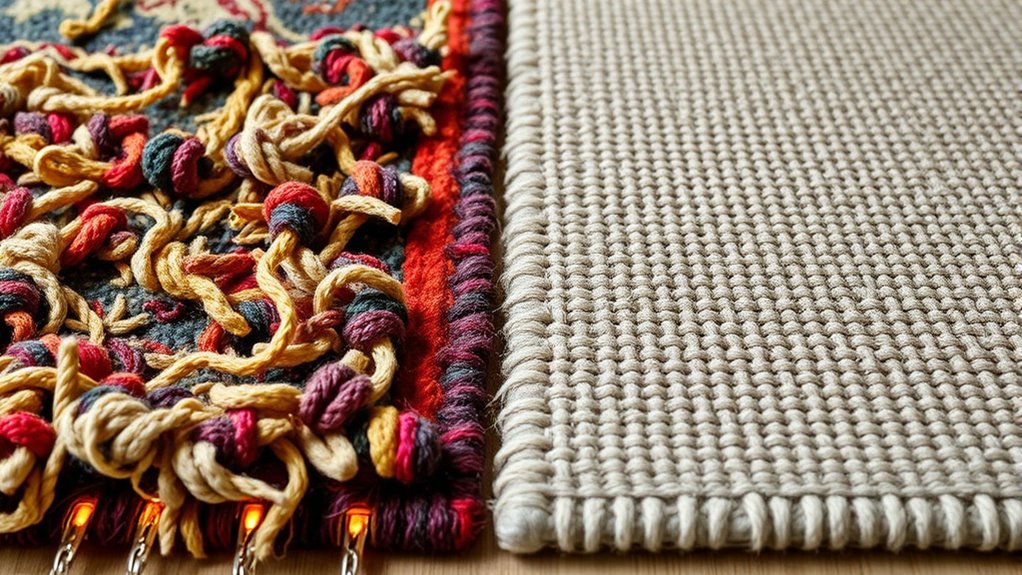
Machine-made rugs are produced using advanced techniques that guarantee consistency and durability. Material selection plays a vital role in quality, with options like synthetic fibers and wool influencing the rug’s performance. The manufacturing process is designed for speed and efficiency, allowing large quantities to be created quickly without sacrificing quality. Additionally, materials used in production often include sustainable options, reflecting a growing emphasis on eco-friendly practices in the industry. Modern machinery also enables precise weaving techniques, resulting in intricate patterns and consistent textures. Incorporating innovative creative practices in manufacturing can further enhance design possibilities and product uniqueness. Furthermore, these processes are often optimized through automation, which increases productivity while maintaining high standards of craftsmanship. Implementing quality control measures ensures each rug meets industry standards and customer expectations.
Manufacturing Techniques Overview
The manufacturing process of machine-made rugs combines advanced technology with efficient production techniques to create consistent and durable carpets. You’ll find that automated looms and computerized systems handle most steps, guaranteeing uniformity across each rug. The process begins with design input, which is uploaded to the machine’s software. The loom then weaves threads quickly and precisely, following the digital pattern. Backing materials are added during weaving to enhance strength and stability, often involving layer bonding or heat-setting techniques. Once woven, the rugs go through finishing processes like trimming, shearing, and quality checks to ensure a smooth, even surface. This method allows for high-volume production, maintaining consistent quality while minimizing waste and production time.
Material Selection & Quality
Choosing the right materials is fundamental to producing high-quality machine-made rugs. You want fibers that are durable, resistant to wear, and suitable for heat, especially for hot floor settings. Synthetic fibers like nylon, polyester, and polypropylene are popular because they’re affordable, colorfast, and easy to clean. Natural fibers such as wool and silk offer added luxury and softness but may require more maintenance. The quality of raw materials directly impacts the rug’s lifespan and appearance, so opt for fibers with consistent thickness and strength. Also, consider the fiber treatment—stain-resistant or anti-static finishes can enhance performance. Ultimately, selecting high-grade materials guarantees your rug maintains its beauty and functionality over time, even under the demands of heated floors. Additionally, understanding the manufacturing process can help you assess the overall quality and durability of the final product.
Production Speed & Efficiency
Efficient production processes are essential for meeting tight deadlines and maintaining consistent quality in rug manufacturing. In machine-made rug production, automation speeds up the process considerably. Modern machinery can produce large quantities of rugs in a fraction of the time it takes to hand-knot or hand-tuft. You benefit from streamlined workflows that reduce labor costs and minimize errors. Continuous weaving allows for high-volume output, ensuring you get your rugs faster without sacrificing quality. Advanced machinery enables precise control over each step, from dyeing to finishing, boosting consistency across batches. Overall, the speed and efficiency of machine-made production give you the advantage of quick turnaround times, making it ideal for large-scale projects or time-sensitive installations. Incorporating automated manufacturing techniques also helps to improve overall quality control and consistency.
Durability and Maintenance of Rugs on Hot Floors
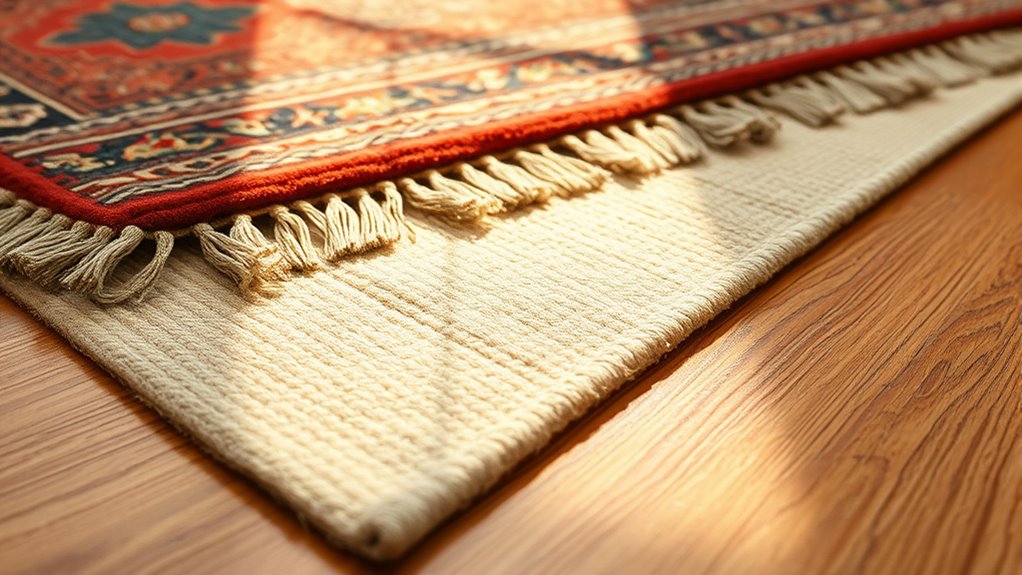
When it comes to rugs on hot floors, understanding their heat resistance is crucial to prevent damage. Regular cleaning and stain care help maintain their appearance and longevity. Keep an eye on wear and tear over time to ensure your layered rugs stay durable and attractive. Incorporating knowledge about sound design techniques can also help you assess the best materials and methods for protecting your rugs from heat-related issues. Additionally, considering AI-driven security systems may provide insights into innovative materials and technologies that enhance rug durability on warm surfaces. Recognizing the importance of filter replacement and maintenance ensures that your rugs remain in optimal condition despite exposure to heat. Proper ventilation and airflow management can further protect your rugs from heat buildup and potential damage. Understanding philosophical insights about authenticity and existence can inspire you to choose ethically sourced and sustainably produced rugs that last longer on hot floors.
Heat Resistance Properties
Ever wondered how well rugs can withstand the heat from heated floors? Your choice of material plays a vital role in heat resistance. Natural fibers like wool and jute typically handle heat better than synthetic options, which can soften or warp under high temperatures. Hand-knotted rugs often have dense weaves that provide better insulation and durability, maintaining their shape over time. Additionally, automation in business technologies can help manufacturers optimize rug production for heat resistance, ensuring higher quality standards. Machine-made rugs, depending on their construction, may be more susceptible to heat damage if made from synthetic fibers. To guarantee longevity, always check the manufacturer’s recommendations for heat exposure. Properly selected rugs can resist warping, fading, and deterioration caused by hot floors, helping you enjoy both comfort and style without sacrificing durability. Additionally, understanding Special Occasions related to home decor can inspire you to choose the most appropriate rug for your space.
Cleaning and Stain Care
Maintaining your rug’s appearance and durability on hot floors requires regular cleaning and prompt stain care. Vacuum your rug weekly to remove dust and debris that can wear down fibers over time. Use a gentle cleaning solution suitable for your rug’s material, and avoid harsh chemicals that may damage it. When stains occur, act quickly—blot the area with a clean cloth to lift the spill without spreading it. For stubborn stains, test a small, hidden section first. Be cautious with water; excessive moisture can cause mold or warp your rug, especially on heated floors. Regular cleaning not only keeps your rug looking fresh but also prolongs its lifespan, ensuring it remains a beautiful addition to your space. Additionally, consider pet hair management strategies to prevent fur buildup that can be difficult to remove on delicate or heat-sensitive surfaces. Incorporating professional cleaning techniques periodically can also help maintain optimal appearance and longevity on hot floors. Employing AI-driven cleaning tools can further optimize maintenance routines, making it easier to keep your rug pristine. Staying informed about AI security vulnerabilities can help you ensure that your connected cleaning devices remain safe and effective.
Long-Term Wear and Tear
Long-term wear and tear are key factors in keeping your rug looking its best on hot floors. Hot surfaces can accelerate fading, cause fibers to degrade, and lead to uneven wear. To protect your rug, consider the following:
- Rotate your rug regularly to distribute foot traffic evenly.
- Use rug pads to prevent slipping and reduce pressure points.
- Avoid placing heavy furniture directly on the rug to prevent crushing fibers.
- Clean spills promptly to prevent staining and fiber damage.
- Choosing a durable, high-quality rug can significantly improve its resistance to wear and tear.
- Understanding the performance tuning principles can help you select the most resilient materials for your rug, ensuring longevity and durability.
- Regular inspection and preventive maintenance are essential for identifying early signs of damage and addressing issues before they worsen.
Proper maintenance helps extend your rug’s lifespan and maintains its appearance. Hand-knotted rugs typically withstand wear better than machine-made ones, but both require consistent care.
Aesthetic Appeal and Design Options
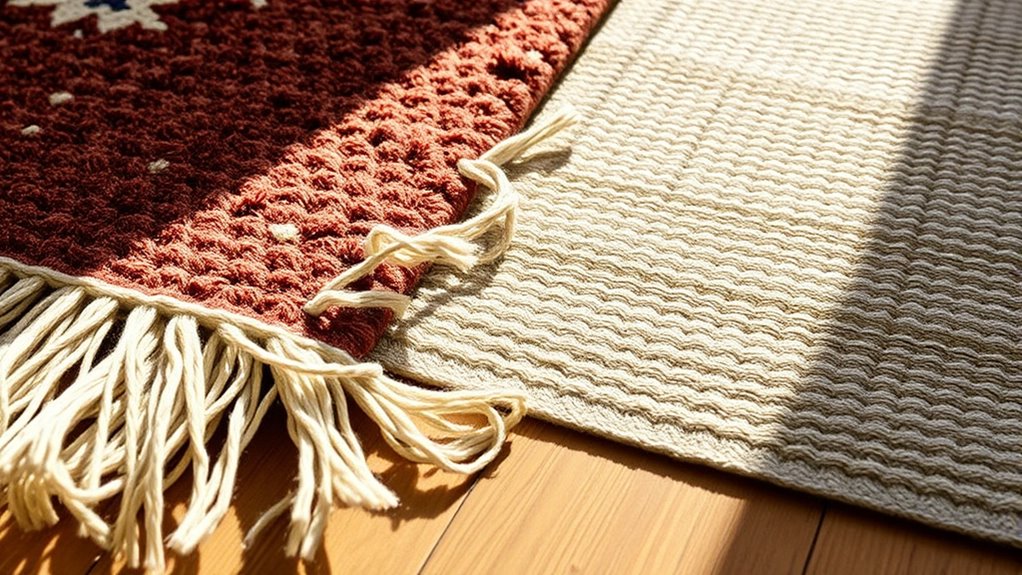
Have you considered how rug layering can transform the look of your heated floors? Layering rugs offers endless design possibilities, allowing you to create a personalized and dynamic space. You can mix patterns, textures, and colors to achieve a layered look that reflects your style. For example, pairing a plush, hand-knotted rug with a sleek, machine-made piece adds depth and visual interest. Layering also helps define different zones within a room, making the space feel more inviting. Whether you prefer a modern, eclectic vibe or a traditional, cozy atmosphere, rug layering gives you flexibility to experiment and express your creativity. This approach not only enhances the aesthetic appeal but also makes your heated floors a central element of your interior design.
Cost Considerations and Value for Money

While layering rugs can enhance your heated floors’ appearance, it’s important to contemplate the costs involved. Hand-knotted rugs generally come with a higher price tag due to their craftsmanship and quality, but they last longer and add value over time. Machine-made rugs tend to be more affordable upfront but may need replacing sooner. Consider these points:
Layering rugs adds style but consider costs: handcrafted rugs last longer, while machine-made options are more budget-friendly upfront.
- Initial investment varies considerably based on rug type and size
- Quality rugs may save money in the long run by lasting longer
- Costs of layering materials and accessories add up
- Budget options might compromise durability and aesthetic appeal
Balancing your budget with your desired look and durability is key. Investing wisely ensures you enjoy the style and comfort without overspending or sacrificing quality.
Tips for Layering Rugs on Heated Surfaces
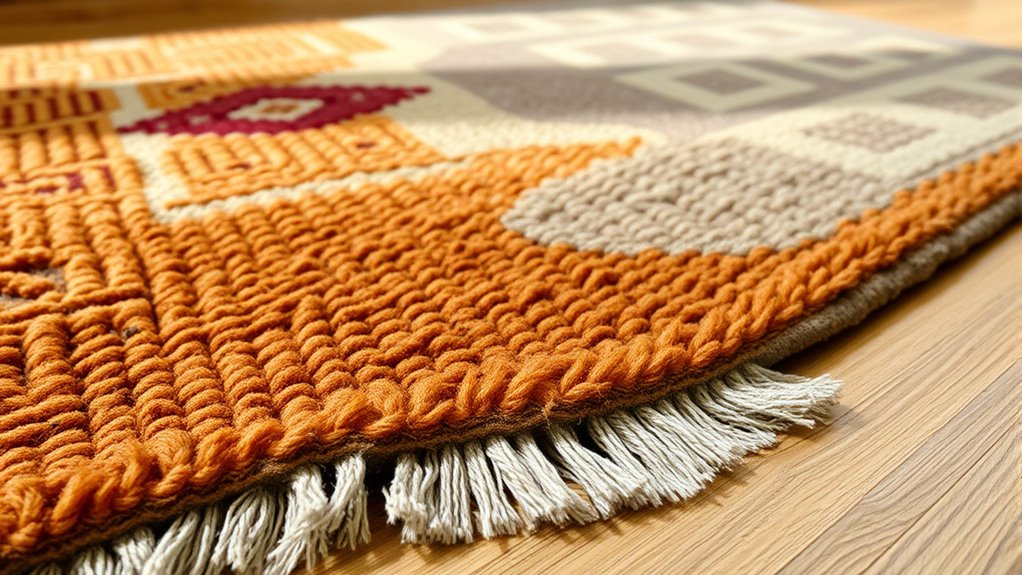
Thinking about layering rugs on heated floors? Start by choosing lightweight rugs that won’t trap heat or add too much insulation. Use non-slip rug pads to prevent slipping and keep rugs securely in place. Arrange your rugs with some space around the edges to allow heat to circulate freely. Avoid thick or dense rugs directly on the floor, as they can trap heat and cause damage over time. Opt for flat-woven or low-pile styles for better heat transfer. Always check the manufacturer’s guidelines to verify the rug isn’t incompatible with heated surfaces. Regularly rotate your rugs to even out wear and maintain airflow. With these tips, you’ll enjoy a cozy layered look without sacrificing comfort or safety on your heated floors.
Frequently Asked Questions
How Does Rug Thickness Affect Heat Transfer on Hot Floors?
You might wonder how rug thickness impacts heat transfer on hot floors. Thicker rugs act as insulators, reducing the heat flow from the floor to your feet. This can make the surface feel cooler and less comfortable in warm weather. Conversely, thinner rugs allow more heat to pass through, keeping your space warmer. So, choosing the right thickness depends on your comfort needs and the level of insulation you want.
Are There Specific Rug Materials Better Suited for Heated Flooring?
Imagine a cozy fire crackling softly—your rug’s material can make that warmth more inviting. For heated floors, opt for natural fibers like wool or cotton, which act like a gentle blanket, insulating heat without blocking it. Synthetic materials may trap heat unevenly or cause discomfort. Choose rugs that are breathable and lightweight, ensuring your floors stay warm without sacrificing comfort or energy efficiency.
Can Layered Rugs Impact the Efficiency of Underfloor Heating Systems?
Layering rugs can affect your underfloor heating system‘s efficiency. Thick, dense rugs insulate heat, making it harder for warmth to reach the room, which might increase your energy use. To keep heat flowing, opt for thinner, breathable rugs or layer with materials that don’t trap too much heat. Proper placement and choosing the right materials help make sure your heated floors stay warm without sacrificing system performance.
What Are the Safety Precautions When Using Layered Rugs Over Heated Floors?
When using layered rugs over heated floors, you should prioritize safety by ensuring rugs are breathable and not thick enough to trap heat. Always check that they’re made from heat-resistant materials and avoid stacking too many. Keep the rugs dry to prevent slipping, and regularly inspect for signs of damage or overheating. Additionally, use rugs with non-slip backings and follow your floor heating system’s manufacturer guidelines for safe use.
How Do Different Rug Backing Materials Influence Heat Insulation?
You should consider how rug backing materials affect heat insulation when layering rugs over heated floors. Rubber or vinyl backings tend to insulate well, trapping heat and keeping it from escaping. Conversely, natural fiber backings like cotton or wool are more breathable, allowing heat to pass through more easily. Choosing the right backing helps maintain warmth and safety, ensuring your floors stay comfortable without overheating.
Conclusion
Choosing between hand-knotted and machine-made rugs depends on your style and budget. Did you know that hand-knotted rugs can last over 100 years with proper care? When layering on hot floors, consider durability and comfort, and don’t forget to select designs that complement your space. Whether you prefer the craftsmanship of a handmade piece or the affordability of a machine-made rug, making an informed choice guarantees your floors stay beautiful and cozy for years to come.
